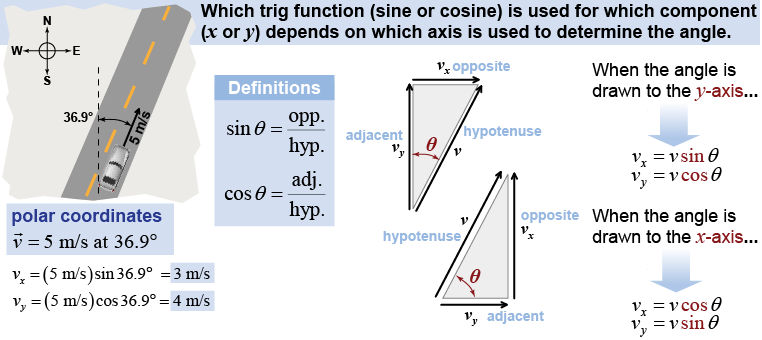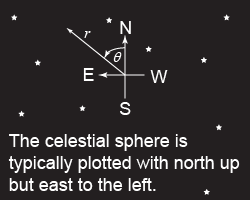|
Velocities are often specified in polar form, giving a speed (magnitude) and an angle, such as = 5 m/s at an angle of 36.9° east of north. Polar vectors are easy to understand but difficult to work with mathematically. 
|
Most of your analysis and problem solving will be done with components in (x,y) form, which are much easier to work with. Therefore you will often need to resolve the velocity vector into components. This is done with a vector triangle just as with force and displacement, except that the axes represent perpendicular velocities. 
|

|
Notice that, in this example, the angle is given relative to the y-axis. If the vector triangle is drawn using the 36.9° angle, the x-component is the opposite side and therefore vx = v sin θ. Because the angle can be drawn to either the x-axis or y-axis, it is a good idea to always sketch the vector triangle to determine whether the x-component uses a sine or cosine ratio relative to the speed. In this example, the x-component uses the sine and therefore the y-component of velocity is given by vy = v cos θ. 
|
If you prefer, you can choose to make all angles relative to the x-axis. If the angle with the y-axis is 36.9°, the complementary angle with the x-axis is 53.1° because the axes always make a 90° right angle. The components in this case have sine and cosine reversed because now the x-component is the adjacent side of the angle: vx = v cos θ and vy = v sin θ. 
|
 The celestial sphere is a coordinate system used by astronomers to describe the night sky. The celestial sphere is usually plotted with north up but east to the left! Why? Lie on your back on the ground with your head pointing north. Your left hand—not your right hand—will be pointing east, because the celestial sphere is reversed with respect to standard map coordinates. As a result, position angles in astronomy are measured from north through east, or counterclockwise. Compare the celestial coordinates with the figure at the top of this page, where the position angle is measured clockwise!
The celestial sphere is a coordinate system used by astronomers to describe the night sky. The celestial sphere is usually plotted with north up but east to the left! Why? Lie on your back on the ground with your head pointing north. Your left hand—not your right hand—will be pointing east, because the celestial sphere is reversed with respect to standard map coordinates. As a result, position angles in astronomy are measured from north through east, or counterclockwise. Compare the celestial coordinates with the figure at the top of this page, where the position angle is measured clockwise! 
|
In the illustration at the top of the page, the velocity vector angle is 36.9° from north, measured clockwise (through east). The corresponding vector angle for “standard geometrical” coordinates is 53.1° from the x-axis.
If the position angle were instead 237° from north through east, what would be the corresponding position angle from the x-axis?
 |
The 237° position angle from north corresponds to an angle that is 57° from the south axis toward the west axis. This corresponds to a 213° angle from the x-axis measured counter-clockwise. 
|

